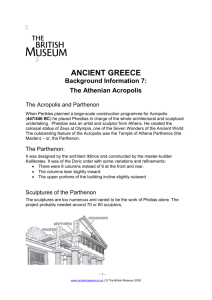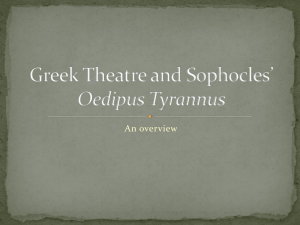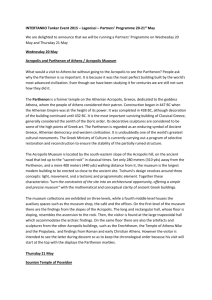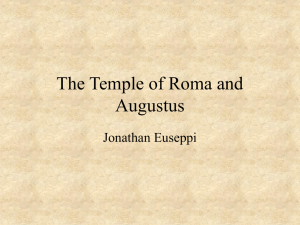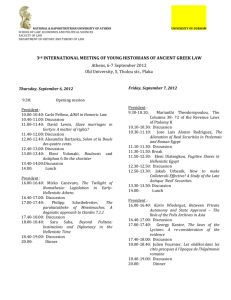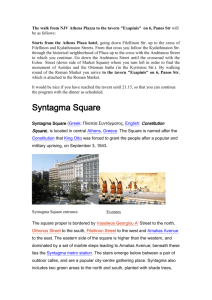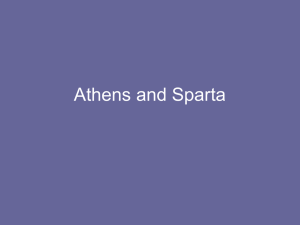Tourist Information
advertisement
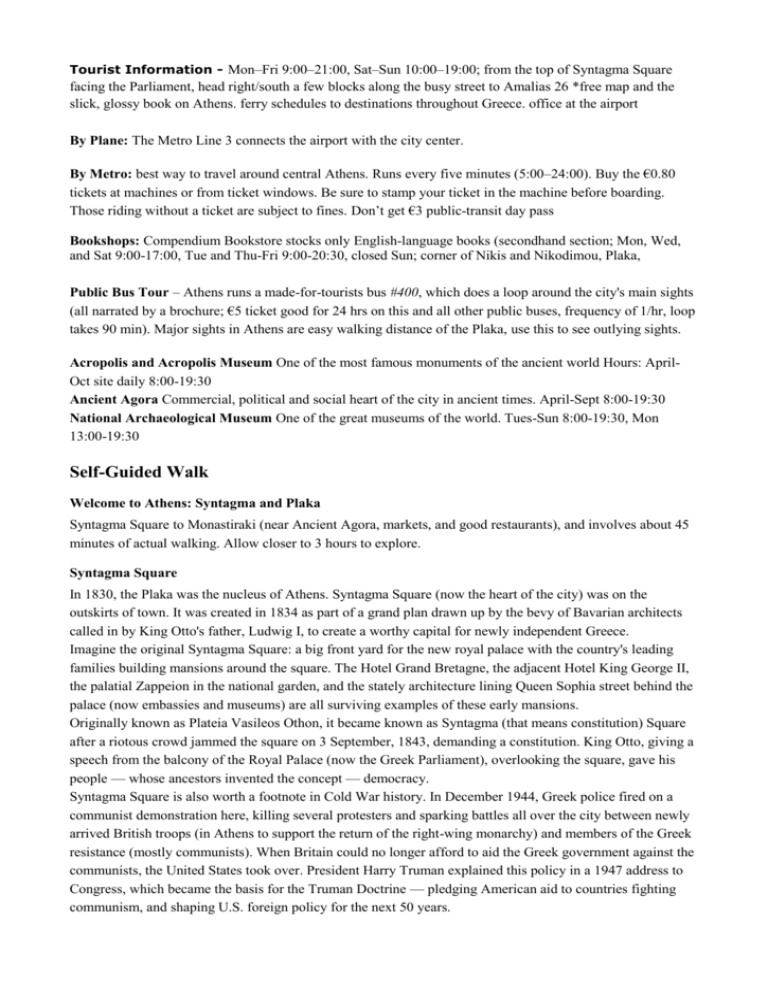
Tourist Information - Mon–Fri 9:00–21:00, Sat–Sun 10:00–19:00; from the top of Syntagma Square facing the Parliament, head right/south a few blocks along the busy street to Amalias 26 *free map and the slick, glossy book on Athens. ferry schedules to destinations throughout Greece. office at the airport By Plane: The Metro Line 3 connects the airport with the city center. By Metro: best way to travel around central Athens. Runs every five minutes (5:00–24:00). Buy the €0.80 tickets at machines or from ticket windows. Be sure to stamp your ticket in the machine before boarding. Those riding without a ticket are subject to fines. Don’t get €3 public-transit day pass Bookshops: Compendium Bookstore stocks only English-language books (secondhand section; Mon, Wed, and Sat 9:00-17:00, Tue and Thu-Fri 9:00-20:30, closed Sun; corner of Nikis and Nikodimou, Plaka, Public Bus Tour – Athens runs a made-for-tourists bus #400, which does a loop around the city's main sights (all narrated by a brochure; €5 ticket good for 24 hrs on this and all other public buses, frequency of 1/hr, loop takes 90 min). Major sights in Athens are easy walking distance of the Plaka, use this to see outlying sights. Acropolis and Acropolis Museum One of the most famous monuments of the ancient world Hours: AprilOct site daily 8:00-19:30 Ancient Agora Commercial, political and social heart of the city in ancient times. April-Sept 8:00-19:30 National Archaeological Museum One of the great museums of the world. Tues-Sun 8:00-19:30, Mon 13:00-19:30 Self-Guided Walk Welcome to Athens: Syntagma and Plaka Syntagma Square to Monastiraki (near Ancient Agora, markets, and good restaurants), and involves about 45 minutes of actual walking. Allow closer to 3 hours to explore. Syntagma Square In 1830, the Plaka was the nucleus of Athens. Syntagma Square (now the heart of the city) was on the outskirts of town. It was created in 1834 as part of a grand plan drawn up by the bevy of Bavarian architects called in by King Otto's father, Ludwig I, to create a worthy capital for newly independent Greece. Imagine the original Syntagma Square: a big front yard for the new royal palace with the country's leading families building mansions around the square. The Hotel Grand Bretagne, the adjacent Hotel King George II, the palatial Zappeion in the national garden, and the stately architecture lining Queen Sophia street behind the palace (now embassies and museums) are all surviving examples of these early mansions. Originally known as Plateia Vasileos Othon, it became known as Syntagma (that means constitution) Square after a riotous crowd jammed the square on 3 September, 1843, demanding a constitution. King Otto, giving a speech from the balcony of the Royal Palace (now the Greek Parliament), overlooking the square, gave his people — whose ancestors invented the concept — democracy. Syntagma Square is also worth a footnote in Cold War history. In December 1944, Greek police fired on a communist demonstration here, killing several protesters and sparking battles all over the city between newly arrived British troops (in Athens to support the return of the right-wing monarchy) and members of the Greek resistance (mostly communists). When Britain could no longer afford to aid the Greek government against the communists, the United States took over. President Harry Truman explained this policy in a 1947 address to Congress, which became the basis for the Truman Doctrine — pledging American aid to countries fighting communism, and shaping U.S. foreign policy for the next 50 years. Breathe deep and ponder the fact that until 1990, Athens was the most polluted city in Europe. It could turn your hanky black in hours. But over the last decade and half, "green" policies have systematically cleaned up the air. Traffic — while still pretty extreme — is limited: even- and odd-numbered license plates are prohibited in the center on alternate days. (Wealthy locals get around this restriction by owning two cars — one with even plates, the other with odd.) While car traffic is down, motorcycles are exempt...and their usage is up. Central-heating fuel is more expensive and much cleaner these days (as required by European Union regulations), more of the city center is pedestrianized, and the city's public transport is top notch. Today the city's busiest subway station dumps people into the café-filled square. Plane trees (chosen for their resilience against pollution and the generous shade they provide) make Syntagma a breezy and restful spot. Around the square, you'll find Athens' most venerable hotel (Grande Bretagne), the American Express office, buses to the airport (parked in front of the City Bank), and the start of the new Athens Coastal Tram. The TI is a few blocks away (down Amalias street). Hike across the busy street at the top of Syntagma Square for a close look at the... Parliament Greece's imposing parliament building, where 300 representatives (elected every four years) tend to the business of state, overlooks Syntagma Square. The origins of this palace of democracy, couldn't have been less democratic. It was built as the Royal Palace by a Bavarian architect, who was under instructions to design a suitably grand home for the new royal family, Otto and Amalia, recently arrived from Nafplio. It was completed in 1842 at a time of rapidly escalating tensions between the new Bavarian elite and frustrated leaders of the War of Independence. If the palace was designed to impress, then the effect was quite the opposite. The conspicuous consumption angered impoverished locals. The palace may have given the appearance of luxury, but life here sucked. The place was terribly impractical.impossible to heat in winter and with only one bathroom among its 365 rooms. Imagine the lines. The palace, badly damaged by fire in 1909 and refurbished in the 1930s, has been the home of the Greek Parliament since 1935. In front of the Parliament buildings is the... Tomb of the Unknown Warrior This monument is guarded by the much-photographed evzones, a special infantry unit of the Greek army. These colorful characters are clad in the traditional pleated kilt (fustanella), white britches, and pom-pom shoes made famous by the klephts, the mountain fighters who battled so ferociously in the War of Independence. The soldiers' skirts have 400 pleats...one for each year of Turkish/Ottoman occupation (and don't you forget it). The evzones change guard every hour on the hour, with a full changing-of-the-guard ceremony, complete with marching band, at 11:00 on Sundays. From the bottom of Syntagma, stroll down... Ermou Street This pedestrian mall leads from Syntagma (next to McDonald's) down into the Plaka, and west to the Keramikos cemetery and the Gazi district. Just a few years ago, this street epitomized all that was terrible about Athens: lousy building codes, tacky neon signs, trucks double-parked, and noisy traffic. When Ermou was first pedestrianized in 2000, merchants were upset. Now they love the ambience created as countless locals stroll through what has become a people-friendly shopping zone. This has traditionally been the street of women's shops (Akadimias is the "men's shopping street"). Many of the department stores on Ermou are housed in impressive neoclassical mansions, and talented street performers (many of them former music professionals from Eastern Europe) provide an entertaining soundtrack. Ermou leads downhill to the... Church of Kapnikarea A classic Byzantine church (11th century, often closed), Kapnikarea is based on a Greek cross (like a plus sign inside a circle, symbolizing the perfection of God) rather than the Latin cross that's common in Western Europe. Telltale signs of a Byzantine church include round arches over the windows, bricks with the mortar surrounding the stones, and a domed cupola symbolizing heaven (always painted inside with the omnipotent "Pantocrator" God blessing us on Earth from its very top). The glass-and-gold-leaf mosaic around the door, while 20th century, is in the traditional style. Notice the focus on the eyes, which were considered a mirror of the soul and a symbol of its purity. The church is named for the tax on the cloth merchants that once lined this square. At the church, turn left and proceed downhill on Kapnikareas Street two blocks, first passing a busy intersection, then the traffic-free Pandrossou Street. Ahead is the Roman Agora. On the right, Pandrossou Street Market leads to Monastiraki Square. (We'll backtrack to here later to finish this walk, going from this intersection through the shopping street.) But for now, we'll circle clockwise on our Plaka tour. Turn left and walk (passing the recommended Hermion Restaurant, on the right) up the pedestrian street to the cathedral. Cathedral This church was built with the arrival of King Otto in 1842. A statue of Damaskinos, archbishop of Greece from 1891–1949, faces the cathedral (generally open daily 8:00–13:00 & 16:30–20:00). As you enter any Greek Orthodox church, join the locals in the standard ritual: Drop a coin in the wooden box, pick up a candle, say a prayer, light the candle, and place in the candelabra. Make the sign of the cross and kiss the icon (in this case the one closest to the door--Jesus). Notice the lipstick smudges on the icon's protective glass. Also notice the candle recycle box behind the candelabra. Orthodox churches come with an altar screen dividing the lay community and the priests. The spiritual heavy lifting takes place behind the screen, where the priests turn the bread and wine into the body and blood of Jesus. Then they open the doors and serve it to their faithful flock--spooning the wine from a challis while holding a cloth under each chin so as not to drop any on the floor. Traditionally, women worshipped apart from men in the balconies upstairs. Women got the vote in Greece in 1954, and since about that time, they've been able to worship in the prime, ground-floor real estate with their men. The scaffolding has decorated this unremarkable church since the earthquake of 1989. Leaving the cathedral, hook left to a smaller but much more historic... Byzantine Church of Agios Eleftherios The marble bits were scavenged from the Ancient Agora in the 12th century. The carved reliefs above the door are part of a calendar of ancient Athenian festivals, thought to have been carved in the second century A.D. The church is sometimes referred to as "the old cathedral," because it was used by the archbishops of Athens after they were evicted from the Parthenon by the Turks. Step inside for pure 12th-century Orthodox architectural beauty. Behind this little church, turn right, following Agia Filotheis for a couple of blocks, then (after a little jog right at the intersection with the busy street) continue along the pedestrians-only Adrianou, a touristy market street. Head uphill a few more blocks until you reach a small square with palm trees, the Byzantine Church of St. Catherine, and the small, ancient Greek excavation (look down at street level from 2,000 years ago). At the traffic street ahead, look left to see Hadrian's Arch, but go right to the... Monument of Lysicrates This elegant marble monument is the sole survivor of many such monuments that once lined this ancient "Street of the Tripods." It was so called because the monuments came with bronze tripods that displayed grand ornamental pottery vases and cauldrons (like those you'll see in the museums) as trophies. These ancient "Oscars" were awarded to winners of choral and theatrical competitions staged at the Theater of Dionysus on the southern side of the Acropolis. This lonely monument was erected in 334 b.c. by "Lysicrates of Kykyna, son of Lysitheides" — proud sponsor of the winning choral team that year. Excavations around the monument uncovered the foundations of other monuments, which are now reburied under a layer of red sand awaiting further study. This lonely monument was erected in 334 BC by 'Lysicrates of Kykyna, son of Lysitheides', proud sponsor of the winning choral team that year. Excavations around the monument uncovered the foundations of other monuments which are now reburied under a layer of red sand awaiting further study. Passing the monument to the left, follow Epimenidou up the steps to the top. At the fork, head right up Stratonos, which leads around the base of the Acropolis. Pass the small St. George of the Rock Church, going straight, and continue gradually uphill. As you immerse yourself in a maze of tiny whitewashed houses, follow signs that point to the Acropolis. This is the community of... Anafiotika This charming "village" is Anafiotika. Literally "little Anafi," it was built by people from the tiny Cycladic island of Anafi who came to Athens looking for work after independence. In this delightful spot, nestled beneath the walls of the Acropolis, the city seems miles away. Weave through narrow paths lined with flowers and dotted with cats dozing peacefully in the sunshine. While ancestors of the original islanders still live here, Anafiotika is slowly becoming a place for wealthy locals to have an "island cottage" in the city. As you wander through the oleanders, notice the male fig trees — no fruit — that keep flies and mosquitoes away. Smell the chicken-manure fertilizer, peek into delicate little yards, enjoy the blue doors and maroon shutters...it's a transplanted Cycladic world. Follow signs to the Acropolis (no matter how unlikely the direction might seem) until you emerge on a concrete ramp at the edge of the houses. This part of the walk circles the Acropolis. Turn right and head downhill back into the Plaka. At the traffic street, head left on the path leading to the Acropolis. After about 30 yards, just before the souvenir shack, turn right. Follow a series of stairs (a lane called Klepsidras) on their perfectly straight course until they dead-end at a black iron fence overlooking the... The Roman Agora and The Tower of the Winds The Romans conquered Greece around 150 B.C. and stayed for centuries. This square was the commercial center of Roman Athens, with a colonnade providing shade for shoppers browsing the many stores that fronted it. Centuries later, the Ottoman Turks made this their grand bazaar. The mosque survives (although its minaret, like all minarets in town, was torn down by the Greeks when they won independence in the 19th century). The only building of any importance for sightseers is on the far right — the octagonal Tower of the Winds. Circle right for a closer look. Built in the first century b.c., the Tower of the Winds was an ingenious combination of clock, weather vane, and guide to the planets. It's named after the beautiful relief carvings that depict the ancient Greek symbols for the eight winds. While even local guides don't know which is which, the reliefs are still beautiful. As you walk down the hill (curving right, then left around the fence), you'll see reliefs depicting a boy with a harp, a boy with a basket of flowers (summer wind), a relief with a circle, and a guy blowing a conch shell--he's imitating Boreas, the howling winter winds from the north. The tower was capped with a weathervane in the form of a bronze Triton (half-man, half-fish) that spun to indicate which wind was blessing or cursing the city at the moment. Bronze rods protruded from the walls and acted as sundials to indicate the time. And when the sun wasn't shining, time was told by the tower's sophisticated water clock, powered by water piped in from springs on the Acropolis. Under Turkish rule, dervishes used the tower as a place of whirling and prayer. Since you can see the tower from the outside, and there's little else to see inside, going into the Roman Agora is not that important (€2, included in €12 Acropolis ticket, daily 8:00–19:30, until 18:00 off-season). But if you buy your €12 Acropolis ticket here, you can avoid lines at the Acropolis and pop into this sight essentially for free for a look at all the sides of the Tower of the Winds (a plaque explains this cool monument). From the tower, head downhill on Eolou. After passing the excavation site of Hadrian's Library (on the left), you'll return to the intersection we stopped at earlier. Remembering that this crowded lane is worked by expert pickpockets, head left down Pandrosou to... Monastiraki Square Stand in the center of the square for this clockwise orientation spin-tour: To the right of the market street (where you entered) stands a former mosque (look for the Arabic script over the door). Known as the Tzami, it was a place of worship from the 15th to 19th centuries, was later briefly used as a barracks and jail, and today houses the Greek Folk Art Museum's ceramics collection (entrance along fence to right of mosque, €2, Wed-Mon 9:00-14:30, closed Tue). Behind the mosque stand the Corinthian columns of Hadrian's Library (second century A.D.). The Acropolis towers behind the library; if you walk toward the library and then turn right on Adrianou, you'll reach the Greek agora. The yellow train station was Athens' original British-built, 19th-century train station — neoclassical with a dash of Byzantium — and functions today as a Metro station. Just past the station, a road leads downhill into the flea market (antiques, jewelry, cheap clothing, artifacts from the Nazi occupation, and so on). If locals need a screw for an old lamp, they know they'll find it here. Opposite the Acropolis, Athinas Street leads straight to Omonia Square, past the bustling Central Market (5-min walk up the street). The small church in the square is the Church of the Virgin (12th-century Byzantine, mostly restored with a much more modern bell tower). The street behind the church is clogged with locals chowing down on the best souvlaki in town Your tour is over. You could conveniently explore the flea market, the central market, the nearby Keramikos cemetery, or dive into the Ancient Agora. Alternatively, you could dive into a spicy souvlaki. Theatre of Herodes Atticus The path up to the Acropolis from the entrance gate offers a bird's-eye view of the Theater of Herodes Atticus. Atticus was a billionaire Greek benefactor, legendary orator, and friend of Emperor Hadrian. This theater — built in A.D. 161 in memory of Atticus' wife, Regilla — is the most famous of many grand buildings around the country financed by Atticus. It was destroyed by the invading Herulians after about a century, and only reconstructed in the 1950s. Today it's used as a spectacular venue for the annual Hellenic Festival, which features an international line-up of dance, music, and theater performed beneath the stars. The theater, also called the Herodion, is open to the public only during performances. It has a Roman-style stage with the stage wall intact. As locals climb up past the many olive trees, they sigh, remembering the trees as "the gift of Athena to Athens." Greece has more than 100 million of these trees. Stop at the base of the grand entry to the Acropolis, at the foot of the many columns of the Propylaia, under the tall, gray stone pedestal with nothing on it. Facing uphill, the Propylaia is before you, the empty pedestal of the Monument of Agrippa is on your left, the Temple of Athena Nike is not on your right (it's been temporarily dismantled for restoration), and the Beulé Gate stands behind you. Now turn your attention to the... Grand Entry The Beulé Gate (you'll walk through it as you exit) is named after French archaeologist Ernest Beulé, who discovered it in 1852 during demolition of a defensive wall built by the Turks. It was built by the Romans in A.D. 267 after the departure of the Herulians, using the rubble of buildings destroyed by the invaders. While the Monument of Agrippa long gone, its 25-foot-high stone pedestal remains. The grand pedestal gives a good indication of the scale of the bronze statue of the Roman general Agrippa, riding a chariot, that once stood here. It was erected in 27 B.C., after Agrippa's victory in a chariot race at the Panathenaic games. Unfortunately, the exquisite Temple of Athena Nike has been disassembled. This perfectly-proportioned little temple, which normally stands on a small spur to the right of the Propylaia (as you face uphill), was dismantled in 2003 for renovation work. Gods willing, they'll put it back soon (possibly in 2007). This is the third time in its 2400-year history that the temple has been taken apart. The Turks pulled it down at the end of the 17th century and used the stone elsewhere, but it was reassembled after independence. It was taken apart for renovations in 1935, and reassembled in 1939. Unfortunately, that work did more harm than good — the steel connecting rods used to hold things together expanded, damaging the stone. This time the restorers are determined to do the job properly, using titanium instead of steel. The temple's designer Callicrates, one of the architects of the Parthenon, would doubtless be wondering what all the fuss is about. He had to make do with lead when he pieced together the original (427-424 BC). It was built to house a statue thanking Athena for victory (Nike) over the Persians. The entrance to the Acropolis couldn't be through just any old gate: it had to be the grandest gate ever built. That's the Propylaia, constructed in about 435 BC and laid out in alignment with the Parthenon. That's the Propylaia, constructed in about 435 B.C. and laid out in alignment with the Parthenon. The Propylaia's large central hallway is flanked by two wings on either side, each with its own gate. The largest gate, in the center, opened onto Panathenaic Way, which was the ceremonial path from the Ancient Agora to the Erechtheion (used for the annual Great Panathenaic Festival, the main event on the city's religious calendar). The Propylaia remained intact until the Franks arrived in the 13th century and converted it into a palace. It later became the home of the Turkish ruler of Athens, and then a storehouse for gunpowder. The Propylaia was seriously damaged in 1645 when the gunpowder magazine was struck by lightning and exploded. Stepping through the Propylaia, you're greeted by the Parthenon. €12 Acropolis ticket gives you entry to five other major ancient sites: the Ancient Agora, the Roman Agora, the ancient Keramikos cemetery, the Temple of Olympian Zeus, and the Theater of Dionysus. Valid for 4 days. Buy the ticket at a sight other than the Acropolis to avoid long lines. Parthenon The Parthenon is the showstopper — the finest temple in the ancient world, standing like a beacon on the highest point of the Acropolis (about 500 feet above sea level). It's impressive enough today, but just try to imagine how awesome the Parthenon must have looked when it was completed nearly 2,500 year ago. This largest Doric temple in Greece, measuring 101 feet by 228 feet, with eight fluted Doric columns at each end and 17 along each side, was completed in just nine years (447–438 B.C.). It's big, sure. But what makes the Parthenon truly exceptional is the extraordinary sophistication of the design. Architects Ictinus and Callicrates, working under the supervision of the master sculptor Pheidias, used a whole bag of optical tricks to bring the building to life. Architects know that a long, flat baseline on a building will give the illusion of sagging, and parallel columns will look like they are falling away from each other. To create a building that looked harmonious, the architects actually calculated bends in the construction, taking into consideration the optical illusions and giving the viewer the sense that all was straight and well. The Parthenon actually curves upwards in the middle, and its columns tilt ever so slightly inwards (one of the reasons why the Parthenon has withstood earthquakes so well). If you extended the columns up several miles, they'd eventually touch. Another trick was to use thicker columns at the corners, which made them appear all the same size. It's amazing to think that all this was planned and implemented in stone so long ago. The Parthenon was built from the very finest materials and decorated with carved scenes of epic tales from Greek mythology created by master sculptors Agoracritos and Alcamenes. The carvings were painted in vivid colors. The best known of these sculptures are the controversial Elgin Marbles, which were removed from the temple's frieze by Englishman Lord Elgin in 1801 and now reside in London's British Museum, despite repeated requests for their return. The Parthenon housed an enormous gold and ivory statue of Athena Polias ("Athena of the City") that was the work of the master Pheidias himself, completed in 432 B.C. Standing 40 feet high, the statue was considered a wonder of the ancient world. The original (which stood at the end closest to the Propylaia) was taken to Constantinople by the Byzantine emperor Theodosius in A.D. 426, and subsequently vanished. We know what it looked like from a Roman copy (the Athena Varvakeion, on display in Athens' National Archaeological Museum). The Parthenon survived intact until A.D. 267, when the Herulians hit town. Before moving on, they did some pretty serious looting and plundering. Fortunately they satisfied themselves with demolishing no more than an interior colonnade. In the fifth century A.D., the temple became a Byzantine Orthodox church, and its interior was decorated with colourful Christian frescoes. It remained a church for almost a thousand years, including a period as a Roman Catholic cathedral under Frankish rule. In 1458, the Turks arrived and converted the Parthenon into a mosque, adding a minaret. The Turks had no respect for the almost sacred history of the place. They tore down stones just for the lead clamps that held them in place to make bullets. (The exasperated Greeks offered them bullets if they'd stop destroying the temple.) The Turks also used it to store gunpowder, leading to the greatest catastrophe in the temple's long history. In 1687 a Venetian army laid siege to the Acropolis. The Venetians weren't worried about the architecture. As far as they were concerned, it was a lucky hit that triggered the massive explosion which ripped the centre out of the Parthenon and wiped out the Turkish defenders. Much work has been done in recent times to stabilise and restore the building. The present work began in 1984, meaning that they've been at it twice as long as it took to build it in the first place. Across the street stands the Erechtheion. Erechtheion The Erechtheion — with its much-loved and much-photographed Porch of the Caryatids — was the most important religious building on the Acropolis. It was built in 406 B.C. on the spot where Athena and Poseidon fought for the naming rights to the city. Athena won by producing a olive tree, symbol of prosperity. The temple gets its strange name from a mythical Athenian king called Erechthonius, supposedly buried under the Caryatid porch. The stones in front of the Caryatid porch, marking the oldest ruins on the Acropolis, are the remains of sixthcentury B.C. Archaic buildings. They sit upon a "Cyclopean" foundation built during the Mycenaean period (1400 B.C.). As you approach the Erechtheion (left of Caryatids), you'll see the huge stones of the Mycenaean construction. The Erechtheion is a complex structure, with three rooms built across a steep slope. The biggest (and least interesting) of these is the main temple, which is divided into two rooms (cellae): one for Athena and one for Poseidon, side-by-side to show that they were still friends. The northern porch, with its six slim, elegant, Ionic columns, is the face that the Erechtheion shows to Plaka. Legend has it that the large crack at the centre of floor was caused by Poseidon's trident during his contest with Athina, but lightening is a more likely culprit. Finally, we come to the Porch of the Caryatids, facing the Parthenon. It's a wonderfully inspired piece of architecture, with six beautiful maidens functioning as columns. These are faithful copies of the originals, five of which are on display here in the Acropolis museum. The sixth was removed by the sticky-fingered Lord Elgin in 1805, shipped to London (on the same boat as Lord Byron), and currently lives at the British Museum. The Caryatids are so called because they were supposedly modeled on women from the town of Karyai (modern Karyes), near Sparta in the Peloponnese, who were famous for their upright posture and noble character. The Erechtheion was part of Pericles' grand plan for the Acropolis. But construction was delayed by the outbreak of the Peloponnesian Wars with Sparta. Work began in 421 B.C., and it was finally completed in 395 B.C. The elevator behind the Erechtheion was constructed for the Paralympics in 2004. It has been kept to lift people with disabilities from the Plaka up to the acropolis. Continue behind the Acropolis, to the low-profile modern building. Acropolis Museum The small museum, housing a wonderful collection of Acropolis statuary, is an essential stop on any visit. Most of the finds actually pre-date the Golden Age and Parthenon. Before the Battle of Salamis, the Persians destroyed the temples standing on the Acropolis. The rubble from these buildings provided a foundation for later building. This so-called "Persian rubble" provided later archaeologists a bonanza of Archaic-period (650-450 B.C.) discoveries that you'll see here. The first rooms show off these oldest statues. Later, in Room IV, don't miss the beautiful korai (maidens) statues. Room VIII contains about 32 feet of the 525-foot-long Parthenon's frieze — the only section that remained following the 1687 explosion and the visit of stony-souvenir-loving Lord Elgin. It shows part of the Panathenaic procession, including the gods receiving all those offerings (panel 856). The highlight is the last room, featuring four of the five remaining original Caryatids. Modern pollution ground their features down to the rough faces you see today. Photographs from 1950 show these Caryatids with crisp facial features. In half a century of Industrial Age pollution, they experienced more destruction than in the previous 2,000 years. In 1998 they were brought inside, out of the acidic air, so thankfully they'll get no worse. Just beyond the museum, at the far end of the Acropolis, climb to the base of the dramatic Greek flag. Acropolis Flag When the Nazis occupied Athens in April 1941, the evzone who guarded this flag was ordered by the Nazis to remove it. He calmly took it down, wrapped himself in it, and jumped to his death. A few weeks later, two heroic teenagers, Manolis Glezos and Apostolis Santas, scaled the wall, took down the Nazi flag, and raised the Greek flag. This was one of the first well-known acts of resistance against the Nazis, and the boys' bravery is honored by a plaque near the base of the flag. To this day, Greeks see this flag from just about anywhere in Athens and think of their hard-won independence. From this viewpoint, look inland at Lycabettus Hill, crowned by the Church of St. George. The white bits on the Pentelican Mountains behind are quarries. The monuments of the Acropolis were built of marble quarried from these mountains— and the stone used to restore the monuments comes from these same, still-active quarries. While the new, white patches you see on the buildings as they are restored seem to be a different stone, they're exactly the same, and will age to fit the stately temples of the Acropolis. Spinning clockwise (to the right), find: The parliament building (facing Syntagma Square), the National Garden behind and to the right of it, the yellow Zappeion, the Panathenaic Stadium, the Temple of Olympian Zeus, and Hadrian's Arch. The Aegean Sea glimmers in the distance, beckoning you to the islands (but the only island visible is Aegina). The Parthenon blocks your view of the port of Piraeus (where boats to the islands embark). The Ancient Agora spreads below the Acropolis, and the sprawl of modern Athens paints the surrounding hills in a rash of white. In 1830, Athens' population was about 5,000. By 1900, it was 600,000. In the 1920s, with the influx of Greeks from Turkey, the population surged to 1.5 million — and the city boomed. With the boom times in the 1950s and 1980s, the city grew to about four million. From this perch, you're looking at the homes of four out of every 10 Greeks. (If that makes you thirsty, there's a water fountain between you and the museum.) Central Market — For a colorful and fragrant stroll through work-a-day Athens, sort through the drippingfresh meat, fish, sticky figs, exotic nuts, spices, and a world of olives at this massive central food market. The market, with lots of immigrant color mixed in, is a barrage on all your senses (Mon–Sat 7:00–15:00, closed Sun, on Athinas between Sofokleous and Evripidou, Metro: Omonia or Monastiraki). Modern-art lovers should pop into the Art Tower, which rises above the market and offers eight stimulating floors of contemporary galleries (free, Wed–Fri 15:00–20:00, Sat 12:00–16:00, closed Sun–Tue, Armodiou 10, tel. 210-324-6100, www.artower.gr). Flea Market — The famous Monastiraki Flea Market stretches west of Monastiraki Square, along Ifestou and its side streets. (every day, best on Sun 8:00–15:00, Metro: Monastiraki or Thisio). Souvenirs —Plaka area, mainly along Adrianou and Pandrossou. room to bargain. Sandals Melissinos Art-- €15-35 per pair (Mon–Sat 10:00–18:00, Sun 10:00–16:00, just off Monastiraki Square at Aghias Theklas 2 Outdoor Cinema - The Aigli Village Cinema is a outdoor theater in the National Gardens (at the Zappeion), playing the latest Cine Paris -outdoor movie venue, Acropolis view (in the Plaka and on the roof of Kydathineon 22, tel. 210324-8057). Nightlife- three squares: Agion Asomaton, Iroon, and Agion Anargyron. FOOD Neon Café, modern, cafeteria-style eatery facing Syntagma Square, for the traveler in a hurry. You'll find a daily selection of Greek favorites as well as salads and pastas. Eat upstairs (€2.50-4 sandwiches, €4-5 salads, €6-7 main dishes, daily 7:00–1:00 in the morning, on the southwestern side of Syntagma Square at Mitropoleos 3 Fast Food Eleni, , daily specials (such as roast pork with lemon and potatoes, €6) (Mon–Sat 11:00–17:00, closed Sun, 200 yards west of Syntagma Square at Perikleos 19, under the big bye-bye sign). Plaka area - Taverna O Thespis (€8-12, daily 11:00–24:00, Thespidos 18, tel. 210-323-8242). Taverna tou Psara appetizers are especially good: You can order a good selection of mezedes (appetizers, €3-13) and forget about a main course. live folk music nightly (not Tues.) from 21:00 (€6-14 main dishes, daily 11:00–24:00, signposted off Tripodon at Eretheos 16, tel. 210-321-8734). 5 Brothers Taverna only good with view…(€5-12, daily 9:30-1:00 in the morning, Eolou 3, tel. 210-3250088). Restaurant lots of salads + fish (€11-26, daily 12:00–1:00 in the morning; with back to cathedral, leave the square downhill to the left, going 50 yards down Pandrosou to Hermion sign, then follow arcade passageway to Pandrosou 15. **Shola Rhio Ouzeri Kouklis fun, inexpensive place to try a variety of traditional mezedes and drink good homemade ouzo. you choose what you like from 1 big dish(€2.50-5 per plate). (Mon–Sat 11:00–24:00, closed Sun, under the Acropolis at Tripodon 14 and Lisiou, tel. 210-324-7605). To Kafeneio, mezedes (€3.50-7 appetizers, daily 11:00–24:00, Epiharmou 1 at Tripodon, tel. 210-324-6916). In Plaka. Platanos Taverna, (€6-10 main dishes, Mon–Sat 12:00–16:30 & 19:30–24:00, closed Sun, Diogenous 4, tel. 210-322-0666). On Monastiraki Square: eat here. Gyros €1.60 Thanasis is famous for souvlaki, made from a traditional recipe that combines ground beef and lamb with Thanasis' secret blend of seasonings (daily 10:00–2:00 in the morning, Mitropoleos 69, tel. 210-324-4705). Savas, similar menu and a little less character (daily 10:00– 3:00 in the morning, Mitropoleos 86, tel. 210-324-5048). Markets: The lively Central Market is about 500 yards north of Plateia Monastirakiou on Athinas. You'll find the best and cheapest selection of whatever's in season at the fruit and vegetable stalls, which spread downhill to the left.Try the roasted almonds and the delicious white figs from the island of Evia. Veropoulos (Mon– Fri 8:00–20:00, Sat 8:00–6:00, closed Sun, just uphill from Veikou at Parthenonos 6) indoor market. Ariston is one of the best places for spanakopita (spinach pie), tiropita (cheese pie), kreatopita (lamb pie), and meletzanitopita (eggplant pie). This is the cheapest and most filling meal in town, and much healthier than a souvlaki. (2 blocks from Syntagma at Voulis 10). Neon 6 Tsakalof, Athens--Kolonaki Sq Snacks 5€-8€; sandwiches 5€-10€; main courses 5€-15€ Giouvetsakia 144 Adrianou and Thespidos, Athens Plaka Nikitas 19 Agion Anargyron, Athens Psirri PriceMain courses 6€-15€ * Giouvetsi pasta and free fruit dish at end Main courses 4€-10€ Oineas 9 Aisopou, Athens Psirri Main courses 8€-15€ Tellis 86 Evripidou, Athens Psirri Main courses 4€-10€ Filistron 23 Apostolou Pavlou Thissio Appetizers 7€-18€ To Steki Tou Ilia 7 Thessalonikis Thissio Main courses 8-16€ Damigos 41 Kidathineon Plaka Main courses 6-10€ 69 Mitropoleos Monastiraki, NE of Monastiraki Square *Mezedes- appetizers … All of the above are Mediterranean Thanasis Main courses 4-10 € *French fries! really good pita

